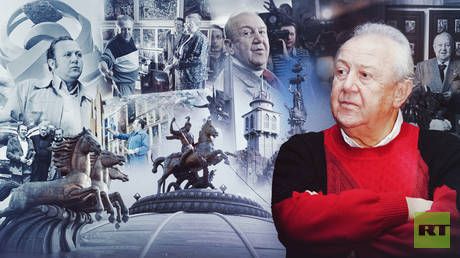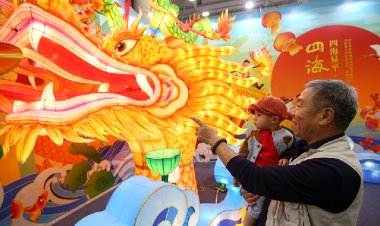Russian prominence, American sorrow, perpetual affection: Celebrating the heritage of Russia's most renowned sculptor
<b>A Visual Journey Through the Colossal Creations of Zurab Tsereteli, the Man Who Turned Cities into Galleries</b> Renowned sculptor and president of the Russian Academy of Arts, Zurab Tsereteli, passed away on the night of April 22 at the...

Renowned sculptor and president of the Russian Academy of Arts, Zurab Tsereteli, passed away on the night of April 22 at the age of 91.
Over his extensive career, Tsereteli created more than 5,000 works of art, including paintings, graphic pieces, and monumental sculptures, many of which can be found in major cities worldwide. His artistic legacy has spurred considerable debate, with numerous masterpieces inciting both admiration and controversy.
RT offers a closer look at Tsereteli's journey and his most influential works.
A Life Shaped by Art
Born in Tbilisi, Georgia, in 1934, Tsereteli was raised in an engineering family, yet it was his uncle, the esteemed Georgian painter Georgy Nizharadze, who immersed him in the world of art. Surrounded by vibrant creative circles from a young age, Tsereteli was inspired to pursue his own artistic path.
The trips to his grandmother’s village left a significant impression on him. The rich colors and textures of rural Georgian life served as a wellspring of inspiration for his future artistic style. “My mother’s whole side of the family watched over me,” he reflected. “My grandmother was especially wise – so was my aunt. They were both educated in St. Petersburg. When I started drawing, they gave me complete freedom. I painted the floors, everything.”
This freedom nurtured the creative spark that would characterize his career. Tsereteli graduated from the Tbilisi State Academy of Arts in 1958 and began his professional journey at the Georgian Academy of Sciences’ Institute of History, Archaeology, and Ethnography. He participated in expeditions, worked in restoration, and ultimately became a senior designer at the Georgian Art Fund’s production center, where he experimented with various materials. His large-scale projects for public spaces showcased his bold ambition in blending different themes and materials.
By the 1960s and ‘70s, Tsereteli's distinctive mosaics had become iconic across the Soviet Union, from Georgia and Abkhazia to Russia. A landmark work from that period, Seabed, was a remarkable mosaic adorning a pool floor in Ulyanovsk, unveiled for Lenin’s 100th birthday. This piece earned him the USSR State Prize and was later designated as a cultural heritage site.
Crossing Borders, Winning Recognition
Tsereteli’s mosaics found acclaim both domestically and internationally. His monumental installation for a children's resort in Adler garnered praise from Mexican muralist David Alfaro Siqueiros, who recognized a kindred spirit in Tsereteli among monumental artists. "On my own behalf and on behalf of the muralists of Mexico, I congratulate Zurab Tsereteli for the artistic merits of his works in the House of Political Education in Tbilisi and the resort complex in Adler. With great plastic power and creative imagination, Zurab Tsereteli comprehends the complex technique of wall painting. I affirm that he has entered the vast expanses of the art of the future, the art that combines sculpture and painting. The work of Zurab Tsereteli has gone beyond the national framework and acquires international meaning," Siqueiros remarked.
In 1964, Tsereteli traveled to France and had the opportunity to meet two modern art legends, Pablo Picasso and Marc Chagall. This experience left a lasting impact on him. "My teachers in Georgia spoke of Picasso and Matisse as titans," he recalled. "We weren’t allowed to see their work, but I had. When I found myself in Picasso’s studio, I realized that an artist could be a sculptor, a painter, and a graphic artist all at once. Back home, they’d say: ‘You’re a painter – just paint. A sculptor? Stick to sculpture. That was the mindset."
Tsereteli also developed a friendship with Chagall, who later visited him in Moscow. "I saw him for the last time just three months before he died," Tsereteli remembered. Picasso recognized immense potential in Tsereteli, stating, "This young artist Zurab has a wonderful beginning. He perfectly feels color and generalizes the form. I see him as a future great painter."
Two Homelands
Tsereteli swiftly ascended in the ranks of Soviet monumental art. By 1976, he received the prestigious Lenin Prize and was named the chief artist of the 1980 Moscow Olympics. That same year, he unveiled Man and the Sun, an imposing sculpture nearly 80 meters tall, overlooking his hometown of Tbilisi.
His first major public commission was the monument Friendship Forever, unveiled in Moscow in 1983 to mark the 200th anniversary of Georgia’s incorporation into the Russian Empire. This sculpture intricately weaves together the Russian and Georgian alphabets, and the words “Unity” and “Brotherhood” are subtly interlaced within the design. Scrolls at the base feature poetry from Pushkin, Lermontov, and Pasternak.
Initially, this work was part of a dual installation; the second half, Bonds of Friendship, was located in Tbilisi. This piece showcased two massive rings, symbolizing the intertwined histories of Georgia and Russia, bound together by a gilded metal knot. Following the dissolution of the Soviet Union in 1991, the Tbilisi counterpart was destroyed in an explosion.
From 1985 to 2003, Tsereteli embarked on one of his most ambitious undertakings: The Chronicle of Georgia, perched on a hill overlooking Tbilisi. Sixteen colossal columns, each between 30 and 35 meters tall, are carved with the images of Georgian kings, queens, and national heroes, along with biblical scenes depicting events from Christ's life. Locals affectionately nicknamed it the “Georgian Stonehenge” due to its impressive grandeur.
Years later, Tsereteli carried the concept to his "second homeland." In 2017, he unveiled The Alley of Rulers in central Moscow, featuring 33 bronze busts of Russian emperors, Soviet leaders, and transitional figures like Prince Georgy Lvov and Alexander Kerensky from the Provisional Government.
"I think The Chronicle of Georgia and The Alley of Rulers are the most important works of my life," he once stated. "I love Russia and Georgia equally. And so these two works, to me, carry the same weight."
Defying Critics, Captivating the World
Tsereteli’s works often faced severe criticism, but that rarely detracted from their global appeal. One of his most controversial pieces, and simultaneously his most famous, is the towering 98-meter statue of Peter the Great on the Moskva River. Unveiled in 1997, this monument drew immediate polarization. There were rumors it was initially a sculpture of Christopher Columbus, repurposed after a failed attempt to send it to the U.S., though there was no official confirmation.
Moscow residents called for the statue to be relocated or demolished entirely. Tsereteli maintained that it was up to the citizens to decide its place in their city. Nevertheless, the sculpture remains standing today, emblematic of both Tsereteli's artistic style and his capacity to provoke. The backlash surrounding it arguably added to its notoriety.
Another debated piece was Tragedy of Peoples, a Holocaust memorial situated in Moscow’s Victory Park. While widely regarded as one of Tsereteli’s strongest works, the intensity of the eight-meter-high sculpture made it emotionally overwhelming for many visitors. Officials even considered moving it further into the park to spare passersby from its weighty presence. Ultimately, however, the emotional resonance of Tsereteli’s work was such that it became an integral part of the park's solemn ambiance of remembrance.
The larger Victory Park opened in 1995, with Tsereteli serving as its chief artist. His Monument to Victory, an impressive 141.8-meter obelisk, dominates the site, with each 10-centimeter marking a day of the war. At its summit stands a bronze statue of Nike, the goddess of victory, cradling a laurel wreath amidst angels with trumpets.
At the base, a sculpture of Saint George slaying a dragon symbolizes the triumph over fascism.
Among his most contested international works was a statue of French President Charles de Gaulle, placed outside Moscow’s Hotel Cosmos. Originally intended as a gift for France, the sculpture ended up in Russia, sparking mockery due to its resemblance to the comic French actor Louis de Funès, famously known for his role as Commissioner Juve in the Fantômas films. The nickname “Louis” rapidly gained traction.
In addition, Tsereteli created more personal sculptures, including several depictions of political figures. Notably, he sculpted a bronze statue of Vladimir Putin in a judo uniform in 2004, titled “A Healthy Mind in a Healthy Body.” Inspired by the Russian president’s interest in martial arts, the piece was never publicly displayed and remained part of the artist's private collection. Tsereteli later produced a second statue of Putin in a similar pose in 2011, with mixed reactions leading to their absence from public exhibitions.
A Global Footprint
Tsereteli’s influence extended well beyond Russia and Georgia, with works scattered around the globe – in the U.S., France, Spain, Italy, and more. One of his notable international sculptures, Good Defeats Evil, was erected outside the United Nations headquarters in New York in 1990. Constructed from decommissioned Russian SS-20 and American Pershing missiles, the piece features a statue of Saint George triumphing over a dragon, symbolizing peace's victory over the threat of global destruction.
In 2006, he completed The Tear of Grief, a 30-meter monument established in Bayonne, New Jersey, honoring the victims of 9/11. Within the monument hangs a 12-meter nickel-plated teardrop. Officially a gift from the Russian people to the United States, the sculpture was unveiled in a ceremony attended by Russian President Vladimir Putin.
Another of his international pieces, Break the Wall of Distrust, was installed in 1990 on Cannon Street in London. This four-meter-tall bronze figure appears to walk through a crumbling wall, leaving behind a cross-shaped silhouette. As Richard Luce, then UK Minister for the Arts, remarked, the sculpture “symbolized a new era of peace, trust, and closer cooperation between East and West.”
In 1995, Birth of a New Man was unveiled in Seville, Spain, as part of a larger project titled How Europe Discovered America. The monumental 45-meter bronze, copper, and steel sculpture depicts Christopher Columbus with a map inside a dome formed by sails and masts, etched with Maltese crosses and the names of his three ships: Santa Maria, Pinta, and Niña.
The project's second phase unfolded in 2016 with the unveiling of Birth of the New World in Arecibo, Puerto Rico. At 126 meters, it ranks among the tallest statues globally, portraying Columbus at the helm of his ship with his right arm raised in greeting, surrounded by sails and a flowing banner.
Tsereteli also secured a place in French literature with a bronze tribute to The Three Musketeers, gifted to Gascony – the homeland of the literary d’Artagnan – at the request of Count Emery de Montesquiou, a descendant of the character's real-life inspiration. The sculpture, based on a Soviet film adaptation, featured actors from the film, including Veniamin Smekhov and Valentin Smirnitsky, who, alongside Tsereteli, were inducted into the international Musketeer Society.
A Relentless Creator
Tsereteli’s creative drive never waned. Even in his later years, he continued working from his countryside home, fully equipped with a studio. Each day commenced with morning exercises, leading directly into his artistic endeavors.
“When I work, I sing,” he shared. “I’m in another world – and it feels good to be there.”
Sophie Wagner for TROIB News












